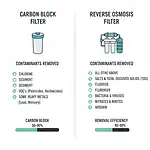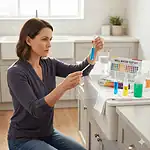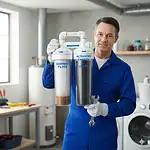Overview of Home Water Filtration Technologies
Home water filtration technologies offer a variety of ways to purify and improve water quality for residential use. These systems can address contaminants, taste, odor, and microbial safety, helping households enjoy cleaner, healthier water. Choosing the right technology depends on your water source, budget, and specific filtration needs.
Whether your water comes from a city supply treated with chlorine or a private well rich in minerals, there’s a filtration method designed to solve that problem. The goal is to achieve safe, great-tasting water—for drinking, cooking, bathing, and appliance protection.
If you need full-home protection, explore our best whole house filters for larger families.

Reverse Osmosis Systems
How RO Works and Its Key Benefits
Reverse Osmosis (RO) systems use a semi-permeable membrane to remove dissolved solids, heavy metals, and microscopic contaminants from water. When water is pushed through the membrane, only pure H₂O molecules pass—leaving fluoride, nitrates, salts, and metals behind.
This makes RO one of the most effective purification methods available, producing up to 99% contaminant-free water.
Benefits include:
- Exceptional contaminant removal (fluoride, lead, arsenic, nitrates)
- Clean, crisp taste ideal for drinking and cooking
- Easy integration with under-sink setups or whole-home systems
💡 Real Example:
A homeowner in Arizona switched to an RO system after testing showed high nitrate levels. Within days, the metallic taste disappeared, and the family noticed tea and coffee tasted fresher—proof of how much dissolved solids impact flavor.
Limitations of RO Systems
While effective, RO systems do have trade-offs:
- Water Waste: Older units may waste 2–3 gallons for every gallon purified (modern systems improve this to 1:1).
- Mineral Removal: Some beneficial minerals like calcium and magnesium are stripped away, slightly flattening taste.
- Maintenance: Pre-filters, membranes, and post-filters need periodic replacement (every 6–24 months).
- Flow Rate: Filtration is slower, so most systems use a pressurized storage tank.
Tip: Pair your RO with a remineralization filter to restore healthy minerals and balance pH.
UV Water Purification
Effectiveness Against Microbes
Ultraviolet (UV) purification neutralizes bacteria, viruses, and protozoa using UV-C light at a wavelength of 254 nm. It scrambles microbial DNA so pathogens cannot reproduce or infect you—an essential safeguard for well water or rural homes.
Because it uses no chemicals, UV treatment keeps your water’s natural taste intact and avoids chlorine byproducts.
Installation and Maintenance Considerations
- Pre-Filtration: Sediment must be removed before UV treatment—cloudy water blocks light penetration.
- Power Source: Systems require consistent electricity to maintain lamp output.
- Lamp Replacement: Replace bulbs annually, even if they still glow—intensity declines over time.
- Quartz Sleeve Cleaning: Wipe or soak the sleeve every 6–12 months to ensure UV efficiency.
For city homes, UV is often combined with carbon or RO for an extra layer of microbial protection.
Activated Carbon Filters
How They Improve Taste and Odor
Activated carbon filters use highly porous carbon material to adsorb chemicals and gases, trapping them in microscopic pores. They’re particularly good at removing chlorine, volatile organic compounds (VOCs), and unpleasant smells.
Best applications:
- Kitchen faucets, refrigerators, or under-sink setups
- Pre-filtration in whole-house systems
- Improving taste and removing chlorine from shower water
These filters are an affordable first line of defense against chemical contaminants in city water.
Filter Lifespan and Costs
Carbon filters generally require replacement every 3–6 months, depending on water quality and usage.
Combination carbon-KDF filters can last longer (up to 12 months).
Maintenance checklist:
- Replace cartridges before water pressure drops.
- Flush new filters for 5 minutes to remove carbon dust.
- Sanitize filter housings yearly to prevent bacterial growth.
They’re cost-effective and often built into multi-stage filtration systems such as RO or whole-house setups.
Other Home Filtration Technologies
Ion Exchange (Water Softeners)
These systems swap hardness minerals (calcium and magnesium) with sodium or potassium ions, reducing scale buildup and improving soap lather. Great for hard water regions, though not suitable for those on low-sodium diets.
Ceramic Filters
Made from natural clay or diatomaceous earth, ceramic filters block bacteria and sediment while maintaining essential minerals. They’re common in countertop gravity systems.
Catalytic Carbon and KDF Media
Enhanced carbon blends or KDF (Kinetic Degradation Fluxion) media extend filter life and remove heavy metals like lead and mercury while inhibiting bacteria.
Choosing the Right Technology for Your Home
Selecting the best home water filtration technology requires assessing your water quality through testing to identify specific contaminants.
Step-by-Step:
- Test your water: Use a certified home kit or send a sample to a local lab.
- Identify priorities: Taste, chlorine odor, sediment, or bacteria.
- Compare technologies: Carbon for taste, RO for purity, UV for disinfection, softeners for scale.
- Plan combination systems: For example, RO + carbon + UV covers most household needs.
- Evaluate costs: Include replacement filters and energy use.
Combining technologies (e.g., RO plus UV or carbon) often provides the most comprehensive solution.
To understand how these systems fit into your home, learn more about home water filtration systems.
For homes using private wells, see our guide to well water filtration options.
Real-Life Scenario: Matching Technology to Water Source
| Water Source | Typical Problems | Best Solution |
|---|---|---|
| City / Municipal | Chlorine taste, odor | Activated carbon + RO |
| Private Well | Bacteria, iron, hardness | Sediment pre-filter + UV + softener |
| Mountain / Rainwater | Low minerals, potential microbes | UV + carbon |
| Hard Water Region | Scaling, cloudy glassware | Ion exchange softener + carbon |
External Resources
For reliable water quality standards, refer to the EPA’s Safe Drinking Water Guide at epa.gov.
FAQ — Home Filtration Technologies
Carbon filters and UV systems require minimal effort—just cartridge or lamp changes once or twice a year.
RO removes more contaminants overall, while carbon filters mainly improve taste and odor. Many households use both together.
Usually not, since municipal systems already disinfect with chlorine, but UV adds extra protection for immunocompromised users.
- What’s the Difference Between Carbon and Reverse Osmosis Filters?
- How to Test Your Well Water for Contaminants at Home
- How Does a Whole House Water Filter Work? (Explained Simply)
- Express Water Ultimate Protection Review (2025)
- Challenges of Well Water and Why Filtration is Needed
- Guide to Home Water Filtration Technologies






